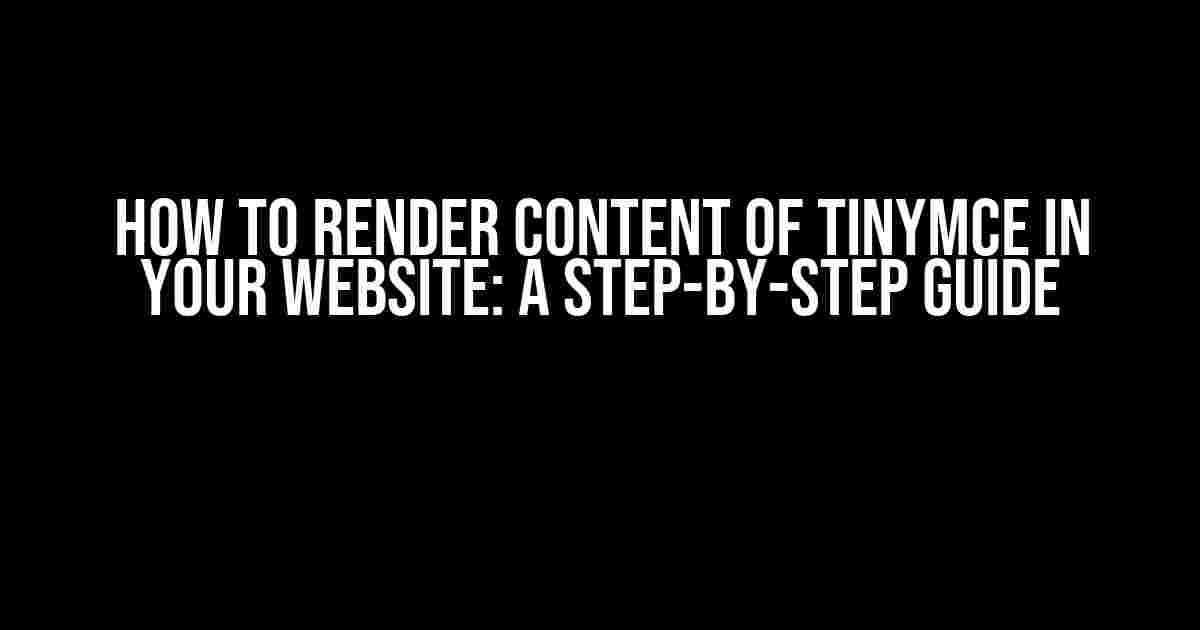If you’re using TinyMCE as your rich-text editor, you might be wondering how to display the content created with it on your website. Don’t worry, we’ve got you covered! In this comprehensive guide, we’ll take you through the process of rendering TinyMCE content on your website, step by step. So, let’s get started!
What is TinyMCE?
Before we dive into the nitty-gritty, let’s quickly cover what TinyMCE is. TinyMCE is a popular, open-source, JavaScript-based rich-text editor that allows users to create and edit HTML content. It’s widely used in Content Management Systems (CMS), blogging platforms, and even custom-built applications.
Why Render TinyMCE Content?
So, why do you need to render TinyMCE content on your website? The answer is simple: to display the content created with TinyMCE in a readable format. When a user creates content using TinyMCE, the editor generates HTML code that needs to be parsed and rendered on the website.
Rendering TinyMCE Content: The Basics
To render TinyMCE content, you’ll need to follow these basic steps:
- Retrieve the TinyMCE content from your database or storage.
- Parse the HTML content to remove any unnecessary tags or attributes.
- Render the parsed content on your website using a templating engine or a programming language.
Step 1: Retrieving TinyMCE Content
In this step, you’ll need to retrieve the TinyMCE content from your database or storage. The process varies depending on your application’s architecture and storage solutions. Here are a few examples:
- MySQL Database: Use a SQL query to retrieve the content from your database table.
- File Storage: Read the file containing the TinyMCE content using a programming language like PHP or Python.
- API: Retrieve the content using an API call to your content management system or storage service.
// Example SQL query to retrieve TinyMCE content
SELECT content FROM articles WHERE id = 1;
// Example PHP code to read TinyMCE content from a file
$file_path = 'path/to/content.txt';
$content = file_get_contents($file_path);
// Example API call to retrieve TinyMCE content
axios.get('https://api.example.com/content/1')
.then(response => {
const content = response.data.content;
// Render the content on your website
})
.catch(error => {
console.error(error);
});
Step 2: Parsing TinyMCE Content
In this step, you’ll need to parse the retrieved TinyMCE content to remove any unnecessary tags or attributes. This step is crucial to ensure that the rendered content is clean, secure, and SEO-friendly.
You can use a HTML parsing library or a templating engine to parse the content. Here are a few examples:
- DOMParser (JavaScript): Use the DOMParser API to parse the HTML content and remove unwanted tags.
- php-html-parser (PHP): Use a PHP library like php-html-parser to parse and clean the HTML content.
- Mustache (Templating Engine): Use a templating engine like Mustache to render the content and remove unnecessary tags.
// Example JavaScript code using DOMParser
const parser = new DOMParser();
const doc = parser.parseFromString(content, 'text/html');
const cleanContent = doc.body.innerHTML;
// Example PHP code using php-html-parser
$html = str_get_html($content);
cleanContent = $html->find('body', 0)->innertext;
// Example Mustache template
<div>{{ content }}</div>
// Example Mustache rendering
const template = Handlebars.compile('{{ content }}');
const renderedContent = template({ content: cleanContent });
Step 3: Rendering TinyMCE Content
In this final step, you’ll need to render the parsed and cleaned TinyMCE content on your website using a templating engine or a programming language.
Here are a few examples:
- Templating Engines: Use a templating engine like Mustache, Handlebars, or Twig to render the content.
- PHP: Use PHP to render the content within an HTML template.
- JavaScript: Use JavaScript to render the content dynamically on the client-side.
// Example Mustache template
<div>{{ renderedContent }}</div>
// Example PHP code to render the content
<?php echo $renderedContent; ?>
// Example JavaScript code to render the content
const container = document.getElementById('content-container');
container.innerHTML = renderedContent;
Best Practices and Security Considerations
When rendering TinyMCE content, it’s essential to consider security and follow best practices to avoid common vulnerabilities:
- Use a Content Security Policy (CSP) to define which sources of content are allowed.
- Use a templating engine or a parsing library to remove unnecessary tags and attributes.
- Escape user-generated content using htmlentities or a similar function.
- Validate user input to prevent XSS attacks.
| Best Practice | Description |
|---|---|
| Use a CSP | Define which sources of content are allowed to prevent XSS attacks. |
| Use a templating engine or parsing library | Remove unnecessary tags and attributes to prevent XSS attacks. |
| Escape user-generated content | Use htmlentities or a similar function to escape user-generated content. |
| Validate user input | Validate user input to prevent XSS attacks and ensure data integrity. |
Conclusion
Rendering TinyMCE content on your website requires careful attention to detail and security considerations. By following the steps outlined in this guide, you can ensure that your website displays TinyMCE content cleanly, securely, and efficiently. Remember to always validate user input, use a templating engine or parsing library, and escape user-generated content to prevent common vulnerabilities.
Now, go ahead and integrate TinyMCE with your website, and start creating rich, engaging content for your users!
Frequently Asked Question
Get ready to unlock the secrets of rendering TinyMCE content on your website! Below, we’ve got the most frequently asked questions and answers to get you started.
How do I integrate TinyMCE into my website?
To integrate TinyMCE into your website, you’ll need to include the TinyMCE JavaScript file in your HTML page. You can do this by adding a script tag to your HTML header, like this: ``. Then, simply initialize TinyMCE on a textarea or div element using the `tinymce.init()` function.
How do I render the content created with TinyMCE on my website?
To render the content created with TinyMCE on your website, you’ll need to retrieve the HTML content from TinyMCE using the `getContent()` method. Then, you can insert this content into your webpage using JavaScript or server-side coding. For example, you can use the `innerHTML` property to set the content of a div element.
How do I preserve the formatting and styling of my TinyMCE content when rendering it on my website?
To preserve the formatting and styling of your TinyMCE content, make sure to include the necessary CSS stylesheets in your website’s stylesheet. You can also use the `content_css` option when initializing TinyMCE to specify a custom CSS file that defines the styling for your content. Additionally, you can use the `cleanup` option to remove any unnecessary elements or attributes from the HTML content.
Can I use TinyMCE with other JavaScript libraries and frameworks?
Yes, you can use TinyMCE with other JavaScript libraries and frameworks. TinyMCE is designed to be modular and flexible, so it can be easily integrated with popular libraries and frameworks like React, Angular, and Vue.js. You can also use TinyMCE with other WYSIWYG editors or custom-built editors.
How do I troubleshoot issues with rendering TinyMCE content on my website?
To troubleshoot issues with rendering TinyMCE content on your website, start by checking the browser console for any error messages. You can also use the TinyMCE debug mode to get more detailed information about the rendering process. Additionally, you can check the HTML content retrieved from TinyMCE to ensure it’s valid and correctly formatted. If you’re still having issues, try searching the TinyMCE documentation or seeking help from the TinyMCE community.


